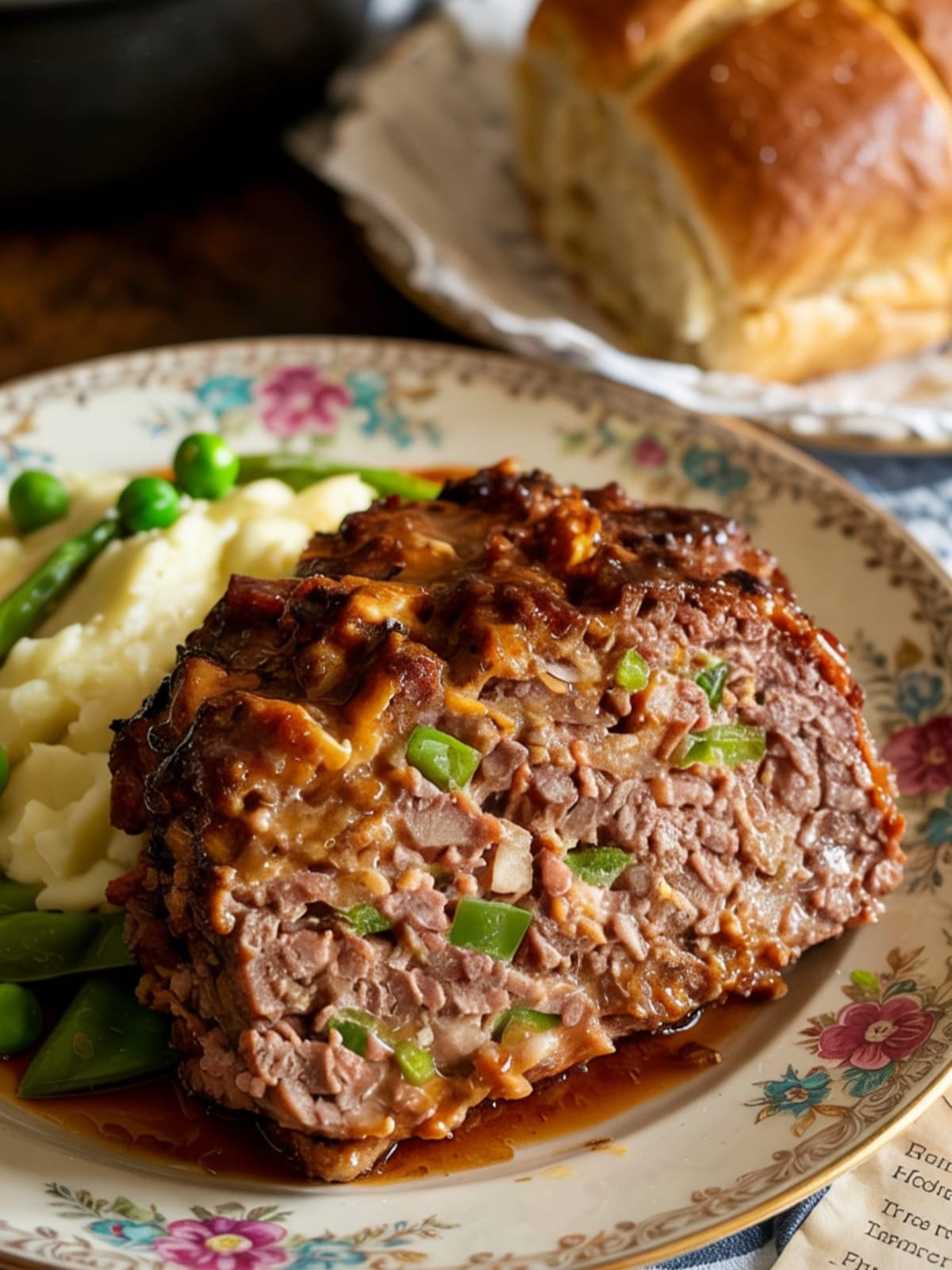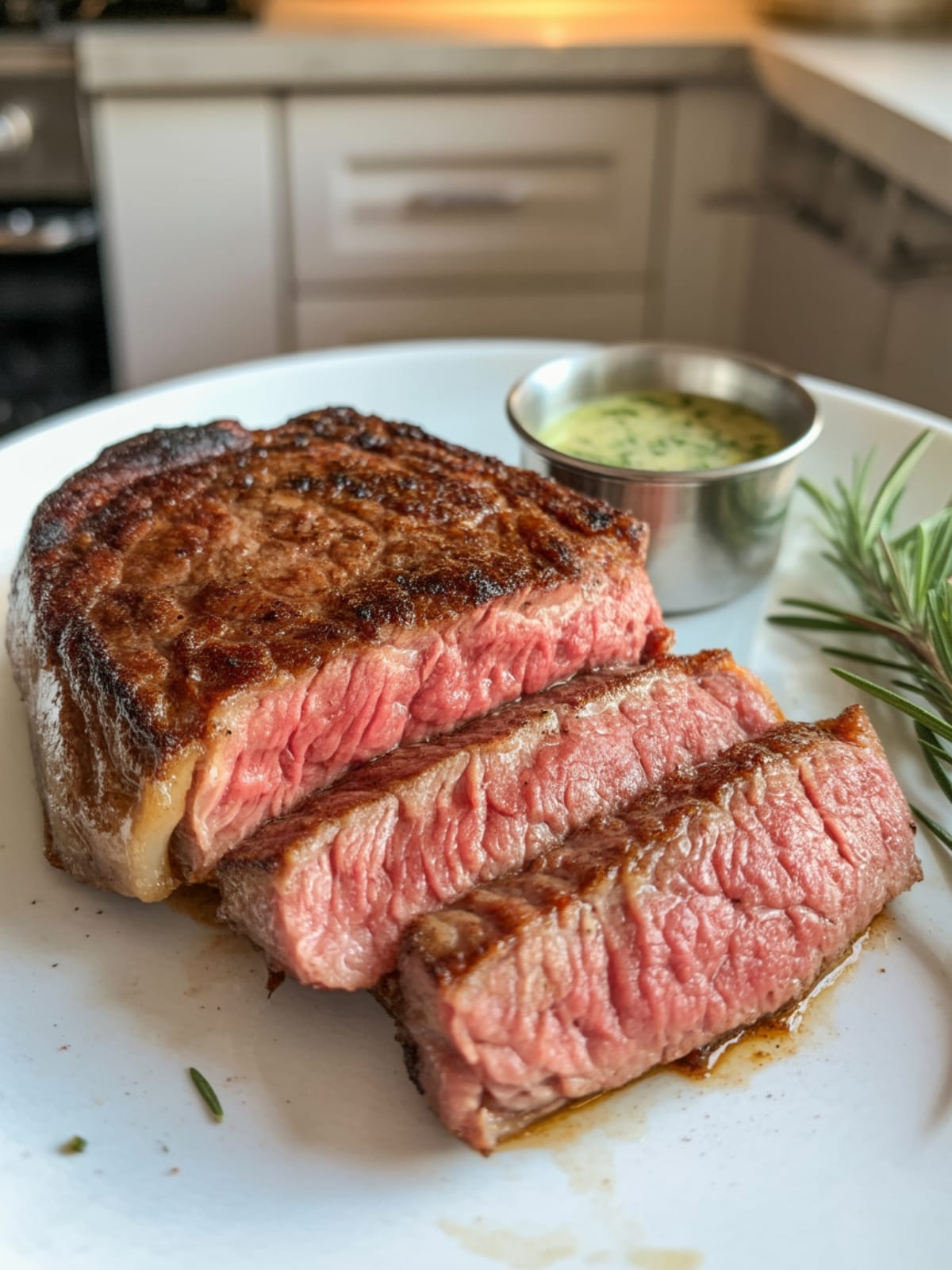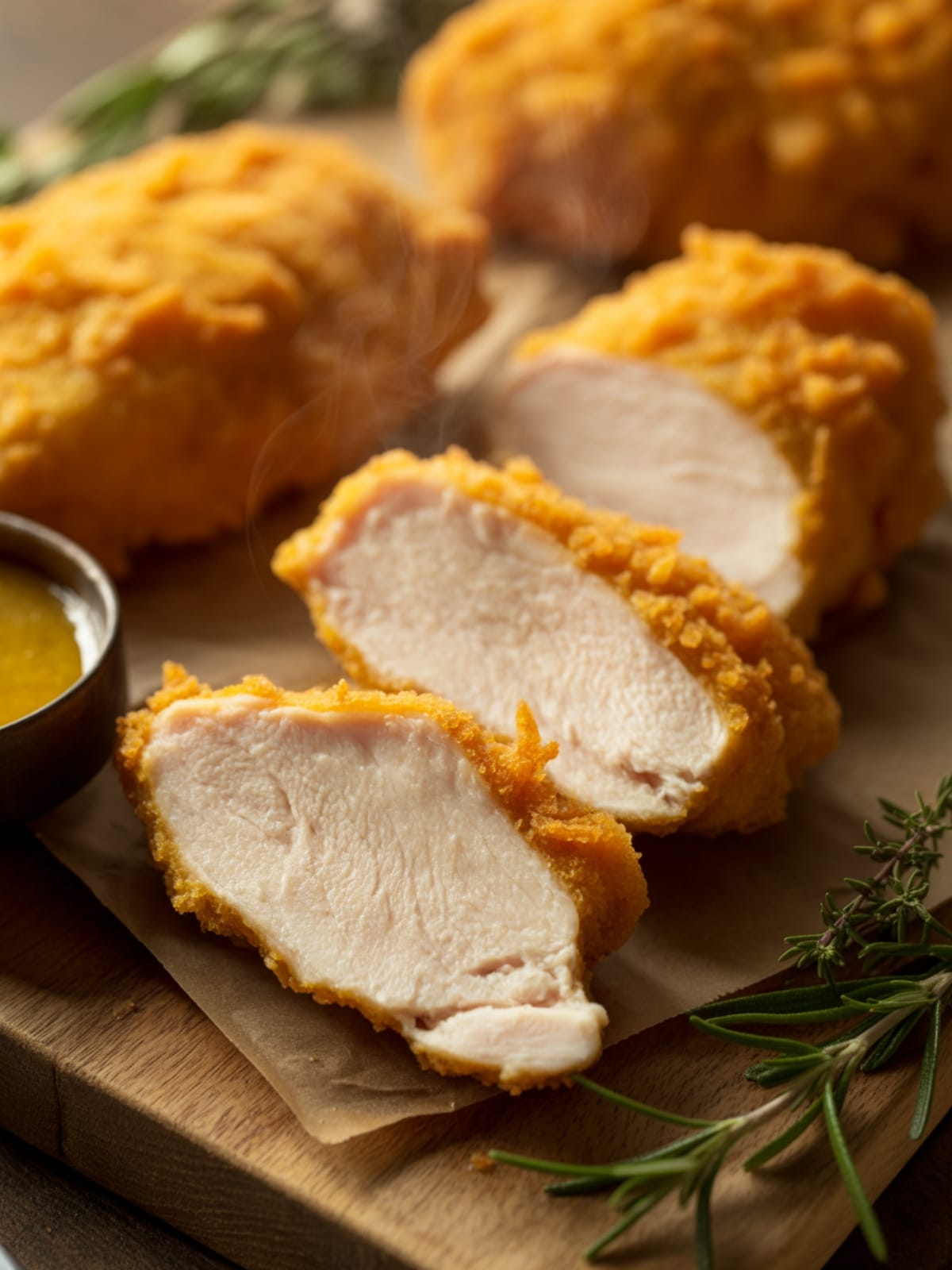Ever wondered why food from grandma’s kitchen always tastes better? There’s something magical about recipes passed down through generations—they carry not just ingredients but stories, memories, and techniques refined over decades. This Grandma’s Heirloom Meatloaf embodies that culinary heritage, delivering the kind of honest, unpretentious comfort that makes you close your eyes with that first bite and sigh contentedly. It’s not trendy or fancy, but it’s perfect in all the ways that actually matter when you’re craving a meal that feels like home.
Why This Recipe is Awesome
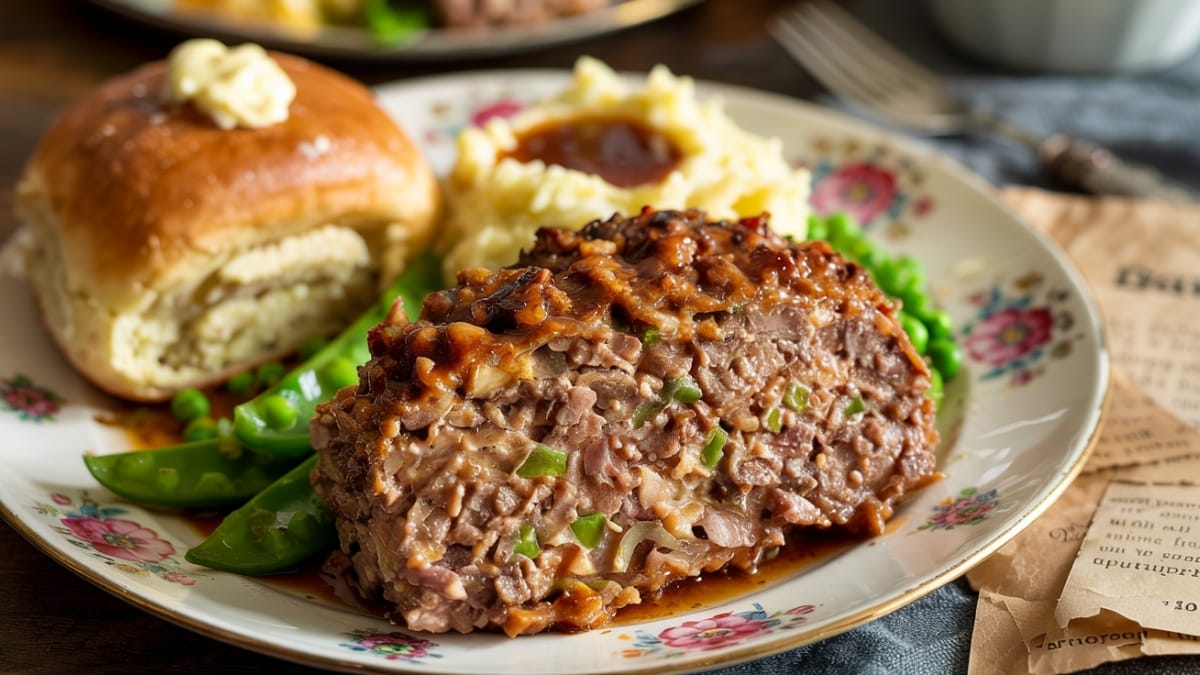
This isn’t just another meatloaf recipe—it’s a time-honored tradition preserved on a sauce-stained recipe card, finally translated for modern kitchens without losing its soul.
The texture is absolutely perfect. Not too dense, not too crumbly, with a moistness that defies the dry, disappointing meatloaves that have given this classic dish a bad reputation. This is the standard against which all other meatloaves should be measured.
What I love most about this recipe is its beautiful simplicity. It doesn’t rely on exotic ingredients or complicated techniques—just everyday pantry staples combined in the right proportions, with a few old-school secrets that make all the difference. The crushed corn flakes (or crackers) might raise eyebrows among culinary school graduates, but they’re exactly what creates that perfect texture that’s impossible to achieve with breadcrumbs alone.
Plus, it’s incredibly economical and adaptable. You can feed a family for days on one meatloaf, and the leftovers might even be better than the original serving. In a world of flashy, Instagram-ready dishes, this humble meatloaf reminds us that true culinary greatness often lies in mastering the classics.
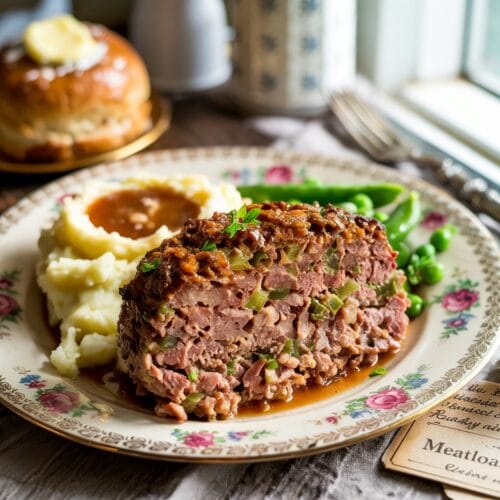
Grandma’s Heirloom Meatloaf
Ingredients
For the Meatloaf
- 2 pounds ground beef 80/20 lean-to-fat ratio
- 1 small onion very finely diced (about 1/2 cup)
- 1 green bell pepper very finely diced (about 1/2 cup)
- 2 large eggs lightly beaten
- 1 cup crushed corn flakes or crushed saltine crackers
- 1/2 cup whole milk
- 1/4 cup ketchup
- 1 tablespoon Worcestershire sauce
- 1 teaspoon yellow mustard
- 1 teaspoon salt
- 1/2 teaspoon black pepper
- 1/2 teaspoon garlic powder
- 1/4 teaspoon dried thyme
For the Topping
- 1/2 cup ketchup
- 2 tablespoons brown sugar
- 1 tablespoon apple cider vinegar
- 1/2 teaspoon Worcestershire sauce
Instructions
- Preheat your oven to 350°F (175°C). Line a 9×5 inch loaf pan with parchment paper, leaving some overhang for easier removal, or lightly grease with cooking spray.
- Prepare the crushed corn flakes. Place corn flakes in a zip-top bag and crush them with a rolling pin, or pulse briefly in a food processor. They should be fine but not powdery.
- Soak the corn flakes. In a medium bowl, combine the crushed corn flakes and milk. Let them soak for 5 minutes until softened. This creates that perfect texture unique to grandma's recipe.
- Mix all ingredients. In a large bowl, combine the ground beef, soaked corn flakes with any remaining milk, diced onion, diced bell pepper, beaten eggs, ketchup, Worcestershire sauce, mustard, salt, pepper, garlic powder, and thyme. Mix gently with your hands until just combined—don't overmix or your meatloaf will be tough.
- Form your loaf. Transfer the meat mixture to the prepared loaf pan, pressing down gently to remove air pockets. Shape the top into a slight dome.
- Make the topping. In a small bowl, whisk together the ketchup, brown sugar, apple cider vinegar, and Worcestershire sauce until smooth.
- Top the meatloaf. Spread the topping mixture evenly over the meatloaf.
- Cover and bake initially. Cover the loaf pan loosely with aluminum foil to prevent the topping from burning. Place in the preheated oven and bake for 45 minutes.
- Finish uncovered. Remove the foil and continue baking for an additional 25-30 minutes, or until the internal temperature reaches 160°F (71°C) and the topping is caramelized.
- Rest before slicing. Allow the meatloaf to rest in the pan for 15 minutes before removing and slicing. This step is crucial for a meatloaf that holds together beautifully when sliced.
- Slice and serve. Using the parchment paper overhang, carefully lift the meatloaf from the pan, transfer to a cutting board, and slice into thick pieces. Serve hot with classic sides like mashed potatoes and green beans.
Notes
- Meat selection matters. Grandma knew that some fat is necessary for flavor and moisture—80/20 ground beef is ideal. If using leaner meat, consider adding a tablespoon of olive oil to the mixture.
- The finer you dice the onion and bell pepper, the more they’ll disappear into the meat mixture—perfect for picky eaters who might object to visible vegetables.
- The milk-soaked corn flakes are non-negotiable. This is what sets grandma’s recipe apart, creating a tenderness that breadcrumbs alone cannot achieve.
- Leftovers make incredible sandwiches. Slice the cold meatloaf thinly and serve on white bread with a little extra ketchup.
- Southern variation: Add 1/4 cup finely diced celery to the vegetable mix for a traditional “holy trinity” base.
- For extra richness, some grandmothers would add 1/4 cup grated Parmesan cheese to the mixture.
- If you don’t have a loaf pan, you can form the mixture into a free-form loaf on a parchment-lined baking sheet. Reduce cooking time by about 10 minutes if using this method.
Calories & Nutritional Info
- Calories: Approximately 350 per serving
- Protein: 23g
- Fat: 21g
- Carbs: 15g
- Fiber: 1g
- Sodium: 650mg
- Iron: 15% of daily value
- Zinc: 30% of daily value
- Vitamin B12: 35% of daily value
- Vitamin C: 10% of daily value (from bell pepper)
Common Mistakes to Avoid
- Using all lean meat. Fat equals flavor in meatloaf. Very lean ground beef will result in a dry, less flavorful finished product.
- Overmixing the ingredients. This creates a dense, tough texture. Mix just until combined for the best results.
- Skipping the milk-soaking step for the corn flakes/crackers. This crucial step ensures moisture throughout the meatloaf.
- Not finely dicing the vegetables. Large chunks of onion or pepper can cause the meatloaf to fall apart when sliced.
- Cutting into the meatloaf immediately after baking. The resting period allows the juices to redistribute and the proteins to set, resulting in neat slices rather than a crumbly mess.
- Using cold eggs straight from the refrigerator. Let them come to room temperature for better incorporation into the meat mixture.
- Forgetting to line or grease the pan. This results in a meatloaf that sticks and falls apart during removal.
Alternatives & Substitutions
- Corn flake alternatives: Crushed saltine crackers, Ritz crackers, or plain breadcrumbs can be substituted in equal amounts. Each creates a slightly different texture, but all work well.
- Meat options: You can use a blend of meats such as 1½ pounds beef and ½ pound ground pork for extra flavor. Some southern grandmothers even added a bit of ground bacon!
- Milk substitutes: Buttermilk adds a nice tanginess, or use chicken broth for a dairy-free option.
- Vegetable variations: Not all grandmas used bell pepper. Feel free to omit it or substitute with grated carrot for sweetness and moisture.
- No ketchup? Tomato sauce mixed with a little brown sugar and vinegar makes a good substitute.
- Spice adjustments: Add 1/4 teaspoon nutmeg for a subtle warmth, or a pinch of red pepper flakes for heat.
- Topping variations: Some family recipes use plain ketchup, others prefer a mixture of ketchup and yellow mustard for a tangy top.
- Make it gluten-free: Use gluten-free corn flakes or crackers, and verify your Worcestershire sauce is gluten-free.
FAQs
Why does this recipe use corn flakes instead of breadcrumbs?
Many heirloom recipes from the mid-20th century use corn flakes or crackers because they create a uniquely tender texture when soaked in milk. They also tend to hold moisture better than breadcrumbs, resulting in a juicier meatloaf.
Can I make this meatloaf ahead of time?
Absolutely! You have two options: 1) Prepare the raw meatloaf mixture, shape it in the pan, cover tightly, and refrigerate for up to 24 hours before baking; or 2) Bake the meatloaf completely, cool, refrigerate, and reheat in a 325°F oven until warmed through, about 20-30 minutes.
How do I know when my meatloaf is done without a meat thermometer?
Insert a knife into the center of the meatloaf—it should come out hot, and the juices should run clear with no pink visible. The meatloaf should also feel firm to the touch and have shrunk slightly from the sides of the pan.
Why does my meatloaf always fall apart when I slice it?
Four common culprits: 1) Not enough binding ingredients (eggs and soaked corn flakes/crackers), 2) Not letting it rest after baking, 3) Vegetables cut too large, or 4) Too much liquid in the mixture. This recipe addresses all these issues for perfect slices every time.
What sides go best with traditional meatloaf?
Classic pairings include mashed potatoes, green beans, corn, or a simple side salad. For a truly nostalgic meal, serve with buttered peas and carrots, and dinner rolls. Mac and cheese is another favorite accompaniment in many Southern households.
Can I freeze this meatloaf?
Yes! You can freeze it either before or after baking:
- Before baking: Prepare the meatloaf in a disposable aluminum loaf pan, cover tightly with foil and plastic wrap, and freeze for up to 3 months. Thaw completely in the refrigerator before baking.
- After baking: Cool completely, slice if desired, wrap individual portions in plastic wrap and foil, and freeze for up to 3 months. Thaw and reheat in the oven or microwave.
My grandmother used oatmeal in her meatloaf. Can I substitute that for the corn flakes?
Yes! Quick-cooking oats can be substituted for corn flakes in equal measure. They should still be soaked in milk as directed. This creates a slightly different texture but works beautifully and is actually a common variation in many family recipes.
Final Thoughts
Grandma’s Heirloom Meatloaf is more than just a recipe—it’s a connection to the past, a celebration of practical wisdom, and proof that sometimes the old ways really are the best ways. In a culinary world often obsessed with novelty and trends, there’s something profoundly satisfying about returning to a dish that has stood the test of time.
What makes this meatloaf special isn’t exotic ingredients or complicated techniques—it’s the attention to small but crucial details that have been refined over generations. The milk-soaked corn flakes, the perfect balance of seasonings, the careful mixing to maintain tenderness—these are the secrets that transform humble ingredients into something truly memorable.
Whether you’re recreating a taste from your own childhood or establishing new traditions for your family, this recipe delivers the kind of genuine comfort that has made meatloaf an enduring American classic. It’s a reminder that great food doesn’t need to be fancy or expensive—sometimes the most satisfying meals are the ones that remind us of home, family, and the loving hands that first prepared them.
